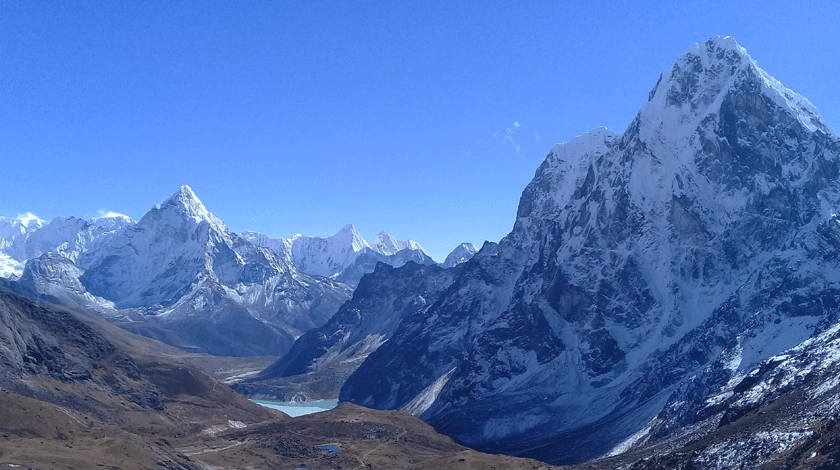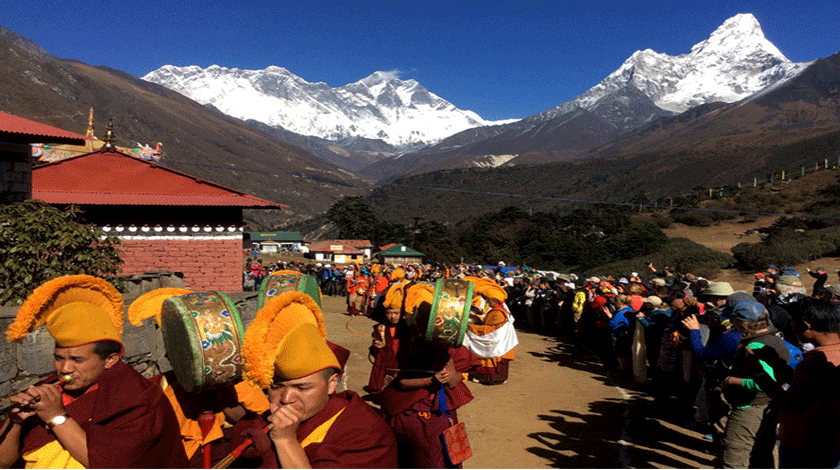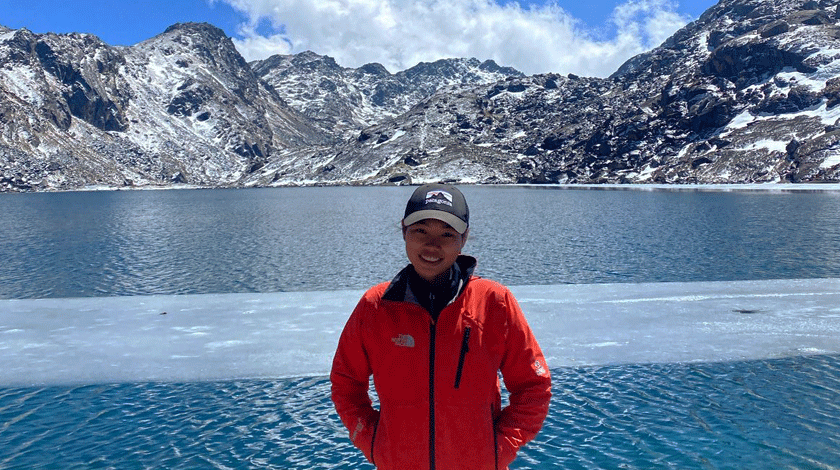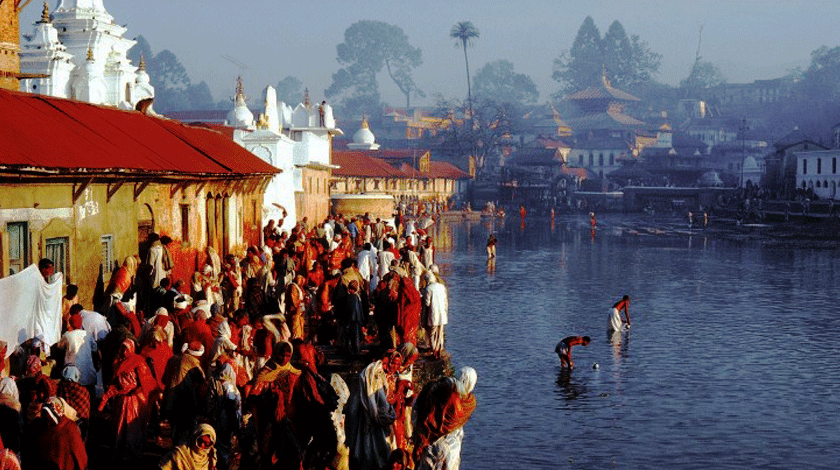Fifth Lake

The Fifth Lake: A Hidden Himalayan Sanctuary
The Fifth Lake (Ngozumpa Lake), is part of the Gokyo Lakes system in the Sagarmatha National Park, Nepal, at approximately 4,700–5,000 meters. The lake’s pristine body of water represents the ultimate destination for adventurers to explore the most remote corners of the Nepalese Himalayas. It holds immense importance from religious, environmental, and adventure perspectives. Here’s a breakdown:
1. Religious and Cultural Significance
- Gokyo Lakes are sacred to Hindus and Buddhists. The Fifth Lake is associated with religious rites and pilgrimages.
- On special occasions like Janai Purnima, many devotees visit the lakes, considering them a holy abode of Lord Vishnu.
2. Scenic Beauty and Viewpoints
- The Lake is a popular alternate route for trekkers heading to Gokyo Ri or Cho Oyu Base Camp.
- It provides an extraordinary view of some of the tallest peaks, including Mount Everest, Cho Oyu, and Makalu. Furthermore, this stunning panorama makes it a truly remarkable vantage point, for photographers seeking the perfect shot but also for adventurers looking to immerse themselves in the grandeur of the Himalayas.
- From the lake, trekkers often climb to Scoundrel’s Viewpoint, offering a breathtaking panorama of the Everest region.
3. Environmental Importance
- Being part of the highest freshwater lake system in the world, it is critical for biodiversity.
- It provides water for local communities and in maintaining the fragile ecosystem of Sagarmatha National Park.
- These glacial-fed lakes are an indicator of climate change. Rapid melting of glaciers can potentially cause glacial lake outburst floods (GLOFs), affecting downstream settlements.
4. Scientific Research
- The lake, being part of a glacial system, is a subject of study for researchers monitoring climate change from glacial retreat to high-altitude ecosystem dynamics and its effects on Himalayan glaciers and water systems.
The Journey to the Fifth Lake
Reaching the Fifth Lake is a challenging expedition that integrates two of the most iconic Himalayan treks: the Three Passes Trek and the Gokyo Everest Base Camp Trek. It demands extraordinary physical endurance, mental resilience, and an unquenchable spirit of exploration. The journey typically begins in Lukla, weaves through the Sherpa capital of Namche Bazaar, and continues through increasingly demanding terrain that tests even the most experienced trekkers.
Key stages of the journey include:
– Namche Bazaar (3,440m): The gateway to the high Himalayas
– Dole (4,038m): A transitional point with breathtaking mountain views
– Machhermo (4,470m): The last substantial settlement before the final push
– Gokyo (4,790m): The base for exploring the lake system
Unlike its more accessible siblings in the Gokyo Lakes chain, the Fifth Lake is a testament to nature’s most extraordinary creations. Nestled near the massive Ngozumpa Glacier—the longest glacier in the Himalayas Gokyo Ri and Lake offers a landscape so otherworldly that it seems to exist beyond the boundaries of conventional geography.
The Challenging Approach
The path to the Fifth Lake tests every ounce of a trekker’s determination. Rocky moraines, glacial landscapes, and extreme altitude create a challenging environment that demands respect and careful navigation. The final approach involves traversing the Ngozumpa Glacier, a living, moving landscape of ice and rock.
Geographical Marvel
The Fifth Lake sits at an elevation of approximately 5,000 meters, making it one of the highest freshwater lakes in the world. Its formation is a result of thousands of years of glacial activity, creating a pristine water body surrounded by some of the planet’s most dramatic mountain scenery.
Ecological Significance
The Fifth Lake represents a critical high-altitude ecosystem. It serves as a crucial water source for the surrounding mountain regions and supports a unique array of microorganisms adapted to extreme conditions. Researchers have discovered remarkable life forms that survive in these seemingly inhospitable environments.
Wildlife Observations
– Rare high-altitude birds
– Himalayan mountain species
– Unique alpine vegetation
Sherpa Cultural Context
For the local Sherpa community, the Lake is more than a geographical feature—it’s a sacred space deeply embedded in their spiritual and cultural landscape. Traditional stories speak of mountain spirits that inhabit these high-altitude regions, with the lake serving as a spiritual nexus point.
Photographic and Scientific Significance
The Fifth Lake offers unparalleled photographic opportunities. Its mirror-like surface reflects the surrounding peaks, including:
– Mount Everest (8,848m)
– Cho Oyu (8,188m)
– Makalu (8,481m)
Trekking Considerations
Successful exploration of the Fifth Lake requires:
– Extensive physical preparation
– Professional high-altitude trekking experience
– Comprehensive acclimatization strategy
– High-quality specialized equipment
– Expert local guide support
Best Trekking Seasons
1. Pre-Monsoon (April-May)
– Moderate temperatures
– Emerging spring vegetation
– Challenging but navigable conditions
2. Post-Monsoon (September-November)
– Clearest skies
– Most stable weather
– Optimal viewing conditions
Conservation and Responsible Exploration
Protecting a Fragile Environment
The Fifth Lake ecosystem is extremely sensitive. Trekkers must adhere to strict environmental guidelines:
– Absolute waste management
– Minimal human impact
– Respect for local ecological systems
– Support for conservation efforts
Practical Information
Essential Permits
– Sagarmatha National Park Entry Permit
– TIMS (Trekkers’ Information Management Systems) Card
– Local conservation area fees
Accommodation
– Basic tea houses in Gokyo
– Limited high-altitude camping options
– Minimal infrastructure beyond Gokyo village
Acclimatization Day
The Fifth Lake serves as an excellent alternative acclimatization spot for trekkers who wish to explore beyond the popular Gokyo Ri. Moreover, the visit to the lake offers breathtakingly close views of Cho Oyu and the Ngozumpa Glacier. Notably, the Ngozumpa Glacier, which lies below Cho Oyu—the sixth-highest mountain in the world—is a remarkable sight. Stretching for an impressive 36 kilometers, this glacier is the longest in the Himalayas. As a large, persistent body of ice, the Ngozumpa Glacier flows slowly due to the stresses induced by its massive weight, further adding to its grandeur.
To plan an acclimatization day to the Fifth Lake, trekkers can follow a gradual climb north along the moraine of the Ngozumpa Glacier. Along the way, they will pass by the Fourth Lake, which provides an additional point of interest en route to the Fifth Lake, situated at approximately 4,980 meters (16,340 feet). While the terrain is rugged, it remains manageable, offering an excellent challenge that keeps trekkers moving and helps with acclimatization.
In addition to these benefits, the Lake offers a quieter and less-trodden route, making it particularly appealing to those seeking solitude and raw natural beauty. Its rugged terrain not only invites exploration but also serves as an ideal camping spot for trekkers eager to venture beyond the usual Gokyo circuit. Once at the lake, trekkers can enjoy serene moments, take stunning photographs, and breathe in the fresh, pristine mountain air.
The Transformative Experience
The Fifth Lake is more than a destination—it’s a profound journey into the heart of the Himalayan wilderness. It challenges physical limits, offers spiritual renewal, and provides a unique perspective on the planet’s most extraordinary landscapes.
For those who dare to venture beyond conventional trekking routes, the Fifth Lake promises an adventure that transcends ordinary travel experiences. It is a pilgrimage through geological time, a test of human endurance, and a deeply transformative encounter with nature’s most sublime creation. The another lake near to the Gokyo is the Thonak lake which can be capture while heading to the Dragnak valley a small village settled before the pass to the Chola pass.
About the Company
Nepal Wilderness Trekking Team provides expert local guides and porters, fully equipped with top-notch gear and comprehensive insurance coverage. Our knowledgeable guides and porters, deeply familiar with the terrain, are committed to ensuring your safety and comfort. Our company serve the export and knowledgable male and feamle guides reffering the guest needs. Their exportise experience 0f the region makes the true sense of difference of journey to the Himalayas.










